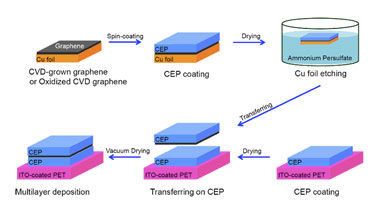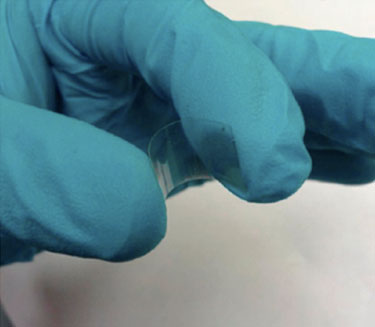Researchers at the University of Austin at Texas in the US and Konkuk University in Seoul, Korea, have fabricated a new type of transparent, flexible dielectric film using graphene and a ferroelectric polymer. The film, which is easy to make, has a high dielectric constant and might be ideal in plastic electronics applications.

Making a graphene dielectric film by a one-step transfer method
Graphene is a single, flat sheet made up of sp2-bonded carbon atoms arranged in a honeycombed lattice. It has many unique electronic properties, such as extremely high carrier mobility – which means that it can function as both an interconnect and high-mobility channel material in ultrafast transistors. The material also absorbs light over a range of wavelengths in the electromagnetic spectrum from the visible to mid-infrared and is transparent to light while being mechanically flexible and incredibly strong.
The researchers, led by Rodney Ruoff, made their dielectric film by sandwiching together the ferroelectric polymer cyanoethyl pullulan (CEP) and graphene. This is the first time that CEP has been combined with graphene in such a study and the polymer of choice until now had been PMMA. The graphene, which makes up the middle of the sandwich, was grown using a technique called chemical vapour deposition. The ensemble was then simply transferred onto another CEP-coated plastic substrate, PET.

Graphene dielectric film on a PET substrate
“Our graphene dielectric film is highly transparent, flexible and has a high dielectric constant of 51,” Ruoff told nanotechweb.org. "What is more, we are able to control the films dielectric constant by varying the level of oxidation of the graphene interlayer.” To compare, the dielectric constant of ferroelectric polymers and high-k thin-films such as hafnium oxide are around 15 and 20, respectively. A high dielectric constant of the film employed in plastic electronics is important because it directly affects device performance.
The graphene forms a space charge layer – that is, an accumulation of polarized charge carriers (electrons and holes) near the graphene polarizes small areas of the sample and thus enhances the dielectric constant of the entire film, he continues. The film may be ideal in plastic electronics applications, such as flexible inorganic electroluminescence devices and embedded capacitors, to name but two examples.
The team previously made a composite film from chlorinated reduced graphene oxide and CEP. Reduced graphene oxide functionalized with chlorine enhances the dielectric constant of the film too thanks to increased interfacial polarization, which, in part, comes from the highly polarizable carbon–chlorine bonds. “Based on these results, and our new work, we would now like to look at how chlorinated graphene interlayers affect graphene-CEP films in an effort to increase the dielectric constant of this hybrid material even further,” said team member Jin Young Kim.


